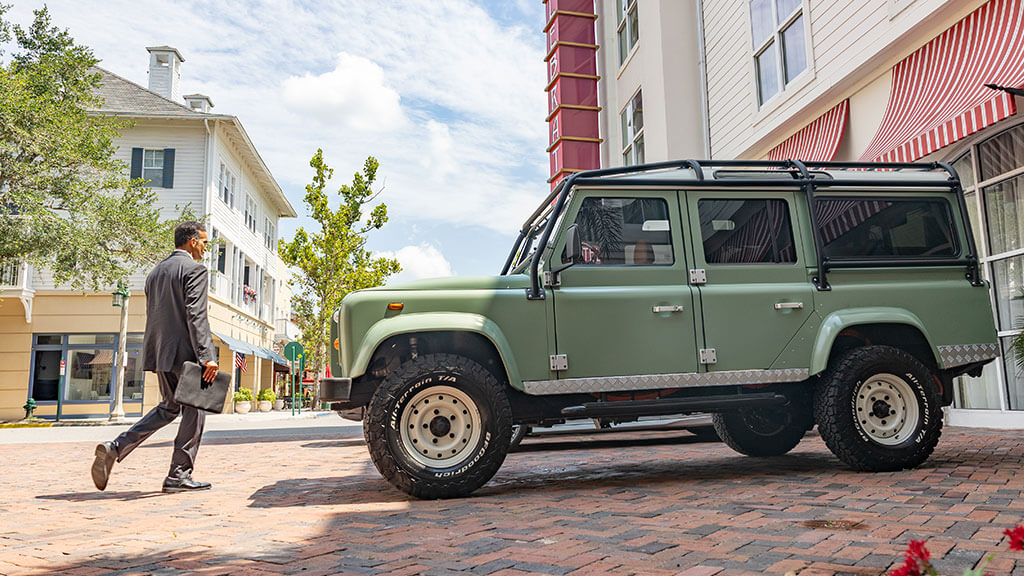Blog
1970 Jaguar E-Type – Timeless Beauty & Design

Classic to Modern Marvels: The ECD Defender
January 10, 2024
2024 Guide to Transforming Your Custom Defender
February 8, 2024The 1970 Jaguar E-Type has always held a particular place in automotive history that enthusiasts just can't escape. The way people feel when encountering an incredible piece of machinery illustrates how a vehicle’s design specs can stir the soul. This was the scene at the 1961 Geneva Motor Show, when the public caught its first glimpse of the Jaguar E-Type.
The E-Type won praise for its balance between beauty and brawn. It also caught notice for offering excellent speed capabilities that were notably more affordable than competitors.
This impressive design fused artistry with functionality and embodied the sensibilities of an era while pushing the boundaries of automotive technology. The E-Type’s long, flowing lines and distinctive silhouette made it instantly recognizable and earned it a place among the most iconic cars of the 20th century.
Its design also influenced a generation of car designers and manufacturers, like the Ferrari 275 GTB. The E-Type’s sleek shape and high performance set a new bar for sports cars and proved that brands could make an attractive car that was also cost-effective. This success inspired other automakers to pursue a better balance of beauty and efficiency.

How Did the Jaguar E-Type Begin?
The 1960s marked a transformative era in the automotive industry. The period saw widespread technological advancements, such as alternators, emissions control, and dual-action tailpipes, and brought a greater appreciation for design details. This dynamic decade served as the backdrop for the Jaguar E-Type — a creation that would embody the spirit of its time and leave an indelible mark on the automotive world.
Jaguar had already gained attention for models like the XK120 and successful D-Type race cars. These set the tone for Jaguar’s engineering strengths while previewing design elements that later E-Types adopted.
Founder Sir William Lyons, director William Heynes, and designer Malcolm Sayer spearheaded the E-Type, starting with several prototypes in the mid-1950s. Lyons valued aesthetics highly in Jaguar’s approach. Sayer brought more science to the design, applying aeronautics principles to shape a curving form with reduced aerodynamic drag.
Watching D-Types win at prestigious races like Le Mans stirred interest in using some of the same components in the E-Type. As a spiritual successor to the D-Type, the E-Type inherited some of that racing association while aiming for more comfort and refinement.
Design and Technical Innovations of the Jaguar E-Type
The Jaguar E-Type was visually appealing and set new standards in automotive engineering. Most notably, it combined sleek design with advanced technology for a perfect harmony of form and function.
Exterior Appeal

The E-Type’s exterior design was revolutionary for its time, with a long hood, glass-covered headlights, and a curved roofline giving it a distinct silhouette. This graceful beauty showcased Malcolm Sayer’s expertise as he sculpted the E-Type’s body to be stunning and aerodynamically efficient. The car’s design also was a departure from the boxier shapes of the era, offering a glimpse into the future of car design. Starting with Series I, the E-Type was available as a fixed-head coupe, roadster, and 2+2 coupe.
Mechanical Innovations
Beneath the striking exterior, the Jaguar E-Type pioneered advanced engineering features. The E-Type blended design elegance with functional performance.
Unibody Construction
The E-Type adopted an innovative unibody — or monocoque — construction method, where the chassis and body are one. This method differed from the separate body-on-frame approach more typical of the era. Monocoque construction provided structural rigidity using less material, resulting in a lighter overall weight. It also brought improvements in handling and safety.
Drivetrain
Power initially came from a 3.8-liter six-cylinder engine, which expanded to 4.2 liters in later Series I models. Along with respectable horsepower, it focused on delivering ample torque. Multiple carburetors fed the advanced dual overhead cam engines to produce strong acceleration.
Braking
In keeping with its sporting nature, the E-Type featured a cutting-edge four-wheel disc brake system — a rare feature among 1960s production cars. Combined with an independent rear suspension design, this system enabled repeated, fade-free stops from high speeds during aggressive driving.
1970 Jaguar E-Type Series: Detailed Overview
The Jaguar E-Type underwent notable changes between the original Series I and later Series II and III. These iterations were responses to evolving regulations and consumer expectations.
Series I (1961-1968)
The debut Series I is considered the most iconic iteration. It launched with a 3.8-liter engine, upgraded to 4.2 liters in 1964 for more torque. It had glass-covered headlights, a small grille opening, and side marker lights above the chrome bumpers. Interiors blended leather seating with an aluminum-accented dash. 1967 saw the unofficial introduction of Series 1 1/2, which removed the glass covering on the headlights. This feature was one of the changes that made it into Series II.
Series II (1968-1971)
The Series II arrived to align with safety and emissions regulations, predominantly in the key US market. Along with open, exposed headlights, the Series II had a larger front air intake that improved cooling capacity. Tail lights also migrated below the bumpers, which grew to fulfill new standards. Inside, mechanical upgrades maintained the 4.2-liter engine while incorporating emissions-focused changes.
The transition from the Jaguar E-Type Series I to the Jaguar E-Type Series II was largely defined by legislative rules, such as emissions requirements, rather than strictly design choices. Regulations shaped many of the external styling tweaks and under-the-hood alterations. They also added head restraints and influenced the ignition and steering column, introducing a steering lock and collapsible steering column.
Series III (1971-1974)
In 1971, the brand introduced the Series III. This series had a 5.3-liter V12 engine, which traded cast-iron construction for aluminum, creating more horsepower for a modest weight increase. Its longer wheelbase also led to a change in manufacturing, with Jaguar no longer producing the fixed-head coupe. Series III E-Types were only available as roadsters and 2+2 coupes. Additional updates were a cross-slat grille, wide tires, V12 badge on the rear, and flared wheel arches.
Jaguar E-Type Performance Metrics
The E-Type delivered sports car performance that surpassed many contemporary vehicles. The introductory 3.8-liter engine enabled a top speed of over 150 mph, accelerating from 0-60 mph in approximately 7 seconds. The later 4.2-liter iteration maintained similar outright speeds while offering enhanced torque and drivability.
Mechanics
The 70s Jaguar Etype featured impressive mechanical specs that put it in a league of its own:
- Engine: The early 1970 Jaguar E-Type had a powerful 4.2-liter inline-six engine known for its strength and reliability. An “inline-six” arranged all cylinders in a straight line on the front of the engine, which differs from vehicles today in which half the cylinders are on one side and the other half on the opposite side (left and right or front and back). Producing an impressive 265 horsepower, it could reach up to 150 miles per hour.
- Transmission: This Jaguar E-Type first came with a Moss four-speed manual shift that lacked synchromesh on first gear, causing difficult shifting during initial take-off. Later models transitioned to a more user-friendly, fully synchromeshed gear shift.
- Braking and suspension: Four-wheel disc brakes and rear-wheel independent coil springs gave passengers the sensation of riding on a cloud. By allowing each rear wheel to react individually to road surfaces, this design maintained better contact for putting power down and changing directions at speed. Handling was precise and unmatched for cars from this era.
Esthetics
The Jaguar E-Type’s design is as much a part of its legend as its performance. The E-Type was sleek — curvy in all the right places. This chic body also gave the car an aerodynamic efficiency, unlike other vehicles of the day. The distinctive shape featured gently sloping lines and a pronounced “power bulge” to create a sense of motion even when stationary. The glass-covered headlights of the Series I, a signature feature, added to its futuristic appeal. The car’s rear was equally striking, with its tapering tail and stylish taillights.
Inside, the 1970 Jaguar E-Type was a luxurious blend of comfort and simplicity. The cockpit was designed with the driver in mind, featuring a wood-rimmed steering wheel and a set of clearly legible dials and gauges. Upholstered leather seats provided comfort and support, enhancing the car’s grand touring capabilities. Attention to detail was evident in the interior’s craftsmanship, from the switches’ placement to the materials used.
A leather interior, an elegant dashboard, improved seats, and additional interior amenities (on later models) enhanced driver and passenger comfort.
Cultural Impact and the Jaguar Legacy
The Jaguar E-Type revolutionized car design and performance and left a lasting impact on popular culture and automotive history.
Influence on Automotive Design
The E-Type’s design influenced a generation of car designers and manufacturers, with its beauty, performance, and affordability setting new standards in the sports car segment. The E-Type’s appeal and engineering prowess became benchmarks for future sports cars.
The Jaguar E-Type in Film and Celebrity Culture
The E-Type’s allure rose to greater heights through its cinema presence and association with celebrities such as Frank Sinatra. It appeared in numerous films and television shows, further cementing its sophisticated status. Many high-profile figures also favored the car, adding to its glamour and desirability. This celebrity association significantly shaped the E-Type’s image as a car epitomizing luxury and success.
Collectibility and Ongoing Appeal
Today, the E-Type is a classic, collectible car. Its enduring appeal lies in its ability to encapsulate the spirit of the era while remaining timeless in its design. Collectors and enthusiasts are drawn to the E-Type for its historical significance, visual beauty, and driving experience. Its status as an icon of automotive design is reaffirmed by its continued presence in car shows, auctions, and private collections.
Own a Piece of Automotive History
Throughout its production run, the E-Type evolved to meet changing times and standards yet never lost its essence. Its blend of art and engineering excellence set a new benchmark in car design that continues to inspire.
Are you fascinated by the history and allure of the 1970 Jaguar E-Type? Whether you’re ready to buy this timeless classic or want a restoration project for your E-Type, the ECD Automotive Design team is the go-to expert. Contact us to start your build journey with one of the automotive industry’s most iconic cars.


